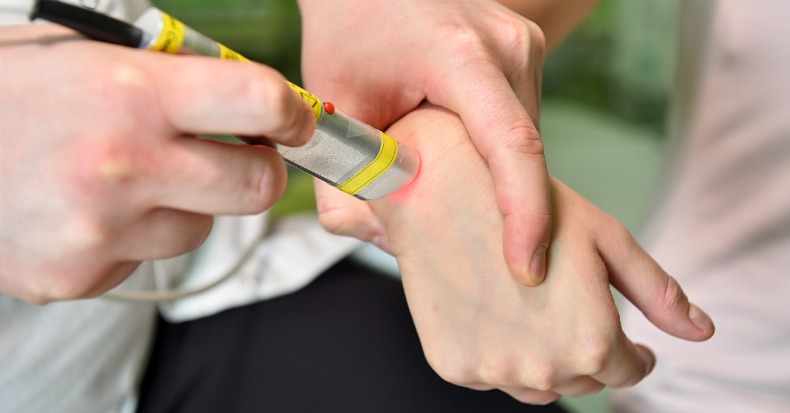Carpal tunnel syndrome (CTS) is a condition that occurs when the mobility and function of the median nerve is restricted as it passes through the wrist, which can result in symptoms like pain, numbness, tingling, and weakness in parts of the hand and some fingers. To reduce inflammation, restore joint motion, and improve median nerve mobility, a doctor of chiropractic will adopt a multimodal approach to give the patient the best opportunity for recovery. One such option that the CTS patient may encounter in the chiropractic setting is laser therapy. Let’s discuss what laser therapy is and how it can benefit a patient under care for CTS.
Low-level laser therapy (LLLT), or class IIIb laser, was cleared for use by the United States Food and Drug Administration (FDA) in the early 1990s. Class IV or high-intensity laser therapy (HILT) received FDA clearance a decade later. By definition, LLLT includes lasers up to 500 mW while HILT are those above 500 mW. The primary difference is that HILT can penetrate further into the targeted tissue. Regardless of wattage, LLLT and HILT both emit energy in a specific range (600nm-1,000nm or from the red to near-infrared portion of the electromagnetic spectrum) that can penetrate the skin and stimulate reactions in the tissues to improve cellular function, which can reduce pain and accelerate healing.
A study published in 2020 that included 98 CTS patients found that when combined with specific exercises, both LLLT and HILT are more effective for reducing pain and improving motor function than specific exercises alone. Additionally, the study found that HILT was more effective in this regard, but LLLT improved nerve repair to a greater extent. A 2020 systematic review found that HILT may provide the most benefit for reducing pain when combined with other interventions for the management of musculoskeletal conditions, which includes CTS.
In addition to LLLT or HILT, a doctor of chiropractic may utilize other high- and low-tech tools like e-stim, pulsed electromagnetic field, ultrasound, dietary modifications/supplements, and ice/heat. How your doctor of chiropractic approaches your care will depend on your patient history and examination/diagnostic findings as well as their clinical experience. The good news is the conservative treatment approaches used by chiropractors are often very effective, but if necessary, your doctor of chiropractic can co-manage your condition with other healthcare providers.
Thousands of Doctors of Chiropractic across the United States and Canada have taken "The ChiroTrust Pledge":
“To the best of my ability, I agree to
provide my patients convenient, affordable,
and mainstream Chiropractic care.
I will not use unnecessary long-term
treatment plans and/or therapies.”
To locate a Doctor of Chiropractic who has taken The ChiroTrust Pledge, google "The ChiroTrust Pledge" and the name of a town in quotes.
(example: "ChiroTrust Pledge" "Olympia, WA")
Content Courtesy of Chiro-Trust.org. All Rights Reserved.

